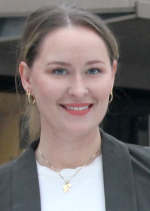The PhD defence and trial lecture will be held in Auditorium 1, The Geology Building. In some cases, it will be possible to attend the trial lecture and dissertation digitally, in that case a link to Zoom will be posted.
Trial lecture
Thursday 17 March, 14:30-15:15, Aud 1, The Geology Building:
Aerosol-cloud interactions and their climate effects
Conferral summary (in Norwegian)
Menneskelig aktivitet har sørget for en stor økt konsentrasjon av aerosoler, som er små faste eller flytende partikler som svever i atmosfæren. Hvis det er mange nok aerosoler i atmosfæren kan de blokkere sollys - og dermed virke avkjølende på jorda. Arbeidet i denne avhandlingen viser at klimamodellene våre ikke gjengir faktisk blokkering av innkommende sollys slik som instrumentene har målt de siste 70 årene. Analyser av iskjerner viser at en grunn til dette kan være at vi har feilestimert hvor mye aerosoler vi har sluppet ut, kombinert med at klimamodellene ikke enes om den atmosfæriske levetiden til en aerosol - og dermed effekten av den.
Main research findings
Popular scientific article about Moseid’s dissertation:
The dim and distant past: Constraining aerosol forcing history in the 20th century
Out of the multiple natural and anthropogenic factors affecting climate, greenhouse gases (GHGs) and aerosols from human activity dominate over the industrial era. The warming effect of the accumulating GHGs in the atmosphere is partly compensated by the aerosol cooling effect by reflecting incoming energy from the sun, and the historical disentanglement of these two effects can be used to estimate the future warming potential.
This doctoral work aids the disentanglement through investigating atmospheric aerosol concentrations and effects over the industrial era. Initial findings show that a subset of state-of-the-art earth system models do not recreate aerosol effects as we see recorded by ground based instruments.

To test whether this discrepancy is caused by errors in the aerosol emission inventories (which are input to these models) we have compared aerosol concentrations in ice cores to that in models and again found discrepancies. Since the discrepancy was most noticeable for Black Carbon (BC), we further investigated the model differences in BC treatment and found a large range in BC atmospheric lifetime.
The longer the aerosol lifetime in the atmosphere is, the larger is the effect, meaning some models overestimate BC effects, despite the initial findings showing models in general underestimate aerosol effects, which underlines the complexity of aerosols' role and effects within the climate system.
Photo and other information:
Press photo: Kine Onsum Moseid, portrait; 500px. Photo: Astrid Bragstad Gjelsvik
Other photo material: Figure with description and credit as specified in the article above, size 1000px.
